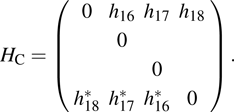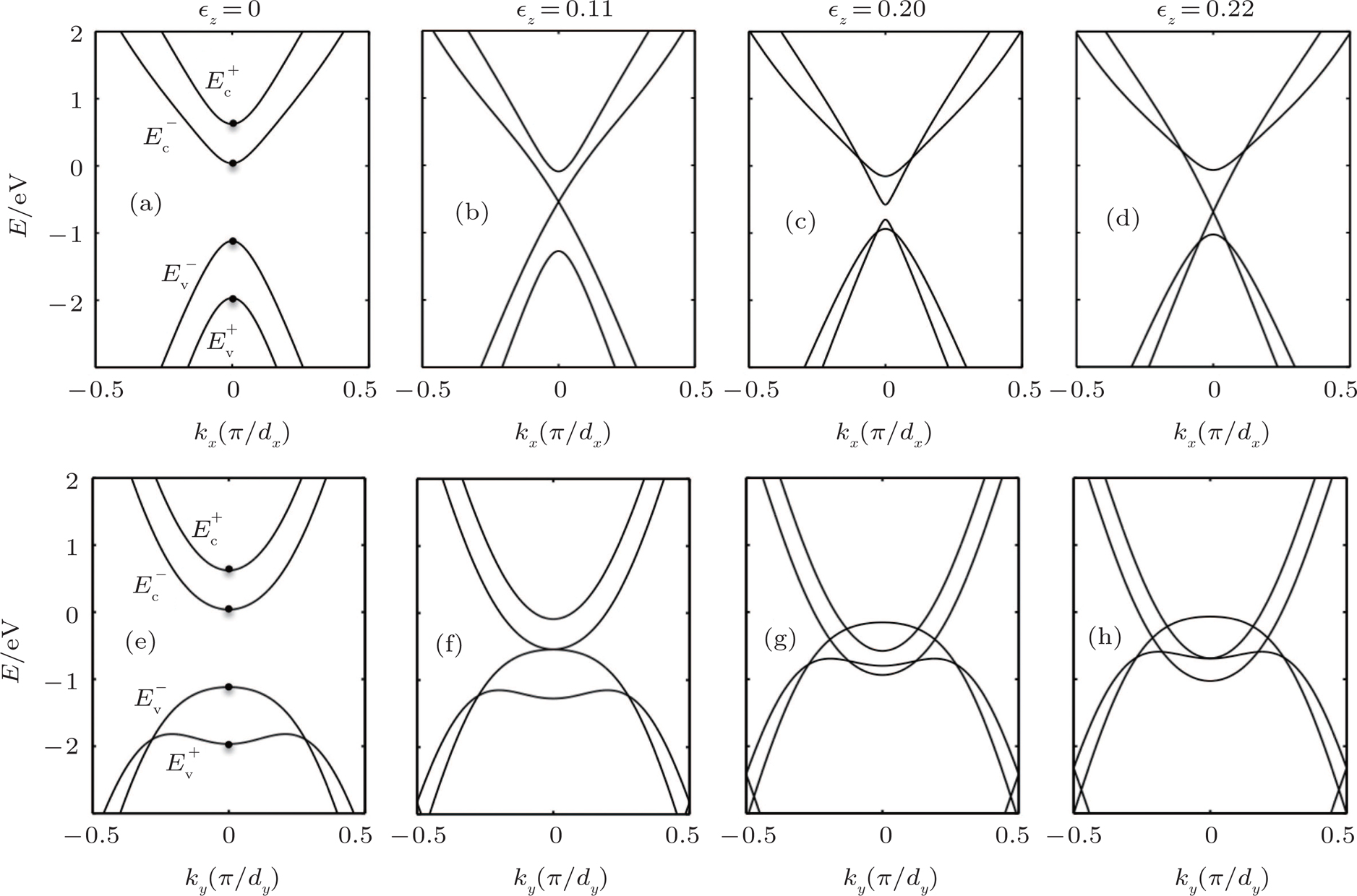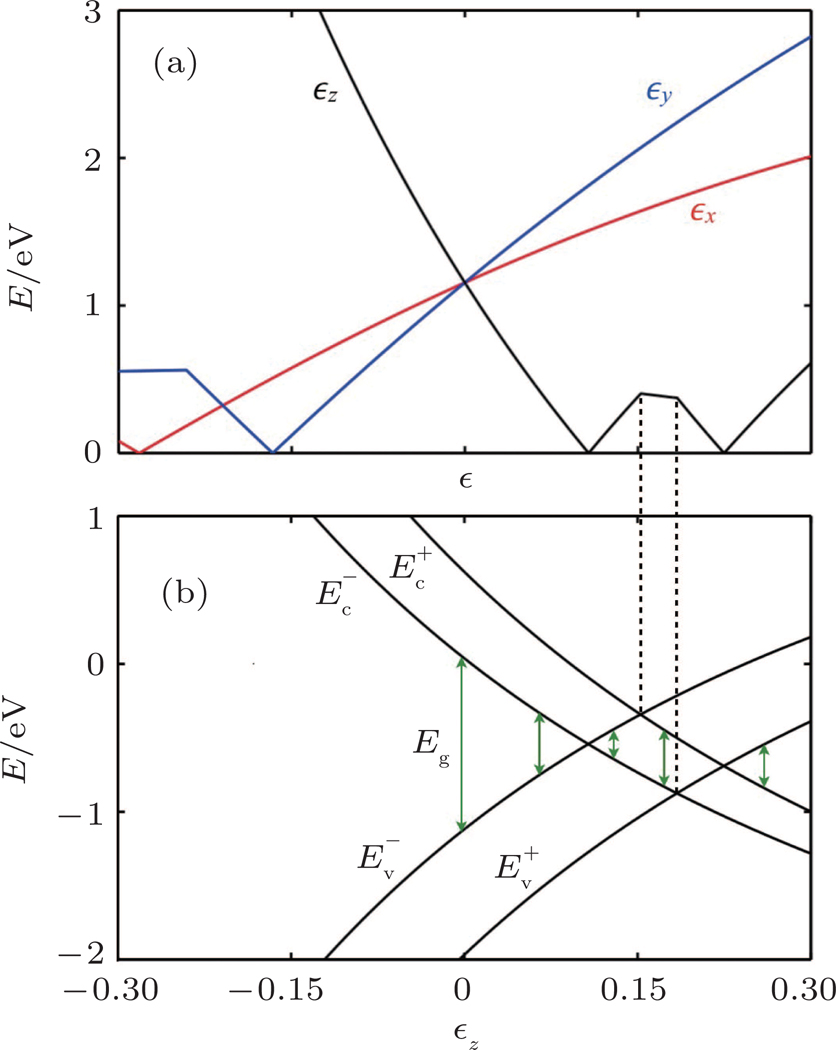† Corresponding author. E-mail:
Strain is a powerful tool to engineer the band structure of bilayer phosphorene. The band gap can be decreased by vertical tensile strain or in-plane compressive strain. At a critical strain, the gap is closed and the bilayer phosphorene is turn to be a semi-Dirac semimetal material. If the strain is stronger than the criterion, a band-inversion occurs and it re-happens when the strain is larger than another certain value. For the zigzag bilayer phosphorene ribbon, there are two edge band dispersions and each dispersion curve represents two degenerate edge bands. When the first band-inversion happens, one of the edge band dispersion disappears between the band-cross points while the other survives, and the latter will be eliminated between another pair of band-cross points of the second band-inversion. The optical absorption of bilayer phosphorene is highly polarized along armchair direction. When the strain is turn on, the optical absorption edge changes. The absorption rate for armchair polarized light is decreased by gap shrinking, while that for zigzag polarized light increases. The band-touch and band-inversion respectively result in the sublinear and linear of absorption curve versus light frequency in low frequency limit.
Few layer black phosphorus, also called phosphorene, was exfoliated from its bulk black phosphorus recently.[1] Phosphorene is regarded as a very promising two-dimensional material due to its excellent electronic, mechanical, and optical properties. Phosphorene has very high mobility[2,3] and possesses a moderate band gap varying from 0.35 eV through 1.73 eV,[4] depending on the number of layers of phosphorene. It was demonstrated that the field-effect transistors of phosphorene have high on-off current ratio at room temperatures, which shows that phosphorene is a good candidate material for electronic application.[5–7] The energy gap is direct, which makes phosphorene become an alternative material that may detect the entire visible spectrum of light and near-infrared light region.[8,9] The band edge optical absorption is extreme anisotropic. Monolayer phosphorene absorbs the light polarized in the armchair direction while cannot take in that polarized along the zigzag direction.[10,11]
Phosphorene is a superior flexible material owing to its puckered honeycomb-like lattice and can sustain strong strain up to 30%,[12,13] which provides the probability to adjust its strain-sensitive properties by exerting strain on the phosphorene sheet. The energy gap as well as the effective mass can be controlled by strain, and this suggests phosphorene has a great potential for switching device fabrication.[11,14,15] Recent literatures reported that strain can tune the band structure of monolayer phosphorene and can turn it to be a semi-Dirac semimetal material when the energy gap is closed.[11,15–17] However, the strain effect on few-layer phosphorene has not been explored yet. The response of multilayer material to external parameters is not always similar as that of its monolayer counterpart. For example, under vertical electric field, the energy gap is enlarged by vertical electric field for monolayer phosphorene[18] while it is narrowed for bilayer phosphorene.[19,20] Whether or not the strain results in the same effects for mono- and multilayer phosphorene needs to be checked carefully. For this reason, we study the electronic structure and optical absorption of bilayer phosphorene under the influence of strain using the tight-binding model. Either vertical tensile strain or an in-plane compressive strain reduces the band gap and the former is the more effective to modify the energy gap. If the applied strain exceeds the critical value for gap closing, a band-inversion happens. For the strain stronger than another certain value, a new band-inversion takes place. Zigzag bilayer phosphorene ribbon hosts two dispersion curves of edge bands in the whole Brillouin zone, while armchair one does not. The interval in k-space where the edge bands exist can be changed by strain. If the strain is applied so as to the first band-inversion occurs, one of the edge band dispersions is eliminated between the band-cross points but the other remains in the whole Brillouin zone. When the second band-inversion happens, the remained edge band dispersion disappears between the second pair of band-cross points. These features of bilayer phosphorene are all qualitative explained based on the band structure of monolayer phosphorene and the interlayer coupling. The optical absorption is almost completely polarized along armchair direction, and the polarization is weakened by gap shrinking. The absorption edges lead to triangle steps on the absorption curve versus frequency for the armchair polarized light. The triangle steps disappear when bands touch, and they evolve into sharp peaks if the band-inversion happens.
The lattice structure of bilayer phosphorene is shown in Fig. 


 |



When a strain is applied on the lattice along the axes, the change of bonds can be described by
 |






 |

Choosing a translational cell and labeling the eight atoms in it by 1 through 8 (see Fig.
 |


 |
 |
 |

Before we diagonalize the Hamiltonian matrix to obtain the band structure, we analyse the bilayer system quantitatively to have some basic features without detailed calculations. A unit cell contains eight atoms, so that there are eight bands in total. Two highest bands and two lowest bands are much far away from the energy gap, and they are not considered in the following. Only four bands, two conduction and two valence bands that are close to the energy gap, are involved into our calculation and discussions. Because the coupling between layers is much weaker than the intra-layer hoppings, the bilayer system can be viewed as two monolayers perturbed by the inter-layer coupling. The energy dispersions of the two monolayers without coupling are degenerate. If turning on the inter-layer coupling, the degeneracy is lifted. Supposing the energy split for the conduction or valence band at the wavevector 


 |
Figure 






Figure 

Phosphorene ribbons have various types of edges, and some types of edges can accommodate edge bands.[24–26] To understand the edge bands of bilayer phosphorene ribbons, we first review the band structure of monolayer ones. For the zigzag ribbon, there exist two degenerate edge bands laying within the energy gap, while no edge band exists in the spectrum of the armchair ribbon. The quantum states belong to two edge bands are localized near the two opposite edges respectively, and the localization length of the edge states can be tuned by normally applied electric field.[26] If applying vertical tensile or compressive in-plane strain, the band gap shrinks. When the band gap is eliminated, the edge band dispersion comes across the band-touch point. For stronger strains, the band-inversion happens, the edge band dispersion joints with the bulk bands at the band-cross points, and no edge band can be found between the band-cross points. The above statements about the edge bands can be verified by the winding number analysis as reported in Refs. [24] and [25].
The edge bands of bilayer phosphorene can also be understood by means of the perturbation of the inter-layer coupling. If no coupling exists, the edge bands for the upper monolayer and those for the lower one are degenerate. When the coupling is turn on, the degeneracy is lifted. Denoting the edge band dispersion of monolayer as 

 |
Figure 






One can find the edge band splitting when the band-touch happens, as shown in Figs.
We consider that a polarized light with the angular frequency ω irradiates normally on a bulk bilayer phosphorene sheet. The light can be modeled by its time-dependent vector potential 




 |

 |





 |
First, we discuss the the optical absorption without strain. From here on, we set 




Second, we turn on the strain 




The electronic structure of bilayer phosphorene can be tuned by strain engineering. Applying a vertical tensile strain or an in-plane strain can decrease the band gap. At the critical strain to vanish the band gap, the bilayer phosphorene becomes a semi-Dirac semimetal material. The band-inversion happens under larger strain. At another certain strain, a new band-touch takes place and the second band-inversion will take place if the strain is increased. Each edge of the zigzag bilayer phosphorene ribbon accommodates two non-degenerate edge band curves in the whole Brillouin zone for the strainless case. If the strain is applied so as to the band-inversion happens, the two edge band curves are eliminated between the band-cross points of the first band-inversion and the second one respectively. The optical absorption of bilayer phosphorene is highly polarized along the armchair direction without strain, while the polarization is notablely weakened for strain-induced band-touch and band-inversion cases. When the gap shrinks, the absorption rate for armchair polarized light or zigzag polarized light decreases or increases respectively. The absorption as function of light frequency is sublinear in the low frequency region if the band-touch happens, and it is linear for the band-inversion cases.
| [1] | |
| [2] | |
| [3] | |
| [4] | |
| [5] | |
| [6] | |
| [7] | |
| [8] | |
| [9] | |
| [10] | |
| [11] | |
| [12] | |
| [13] | |
| [14] | |
| [15] | |
| [16] | |
| [17] | |
| [18] | |
| [19] | |
| [20] | |
| [21] | |
| [22] | |
| [23] | |
| [24] | |
| [25] | |
| [26] |
















